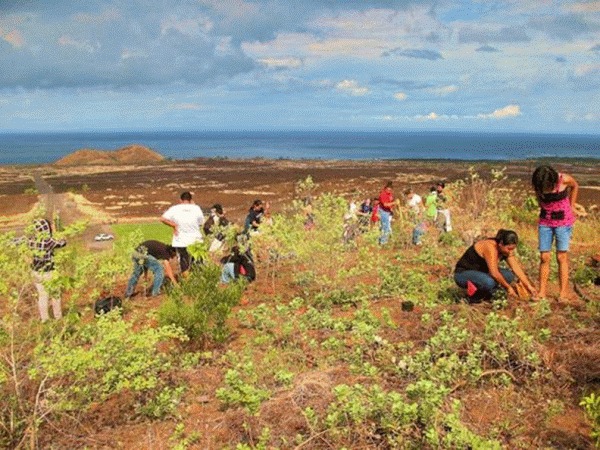In 1997, the West Hawaii Veterans Cemetery was established in North Kona. At that time, the area was dry and full of weeds. The only inhabitants were the goats that foraged for food throughout the area. Because of limited funding,
In 1997, the West Hawaii Veterans Cemetery was established in North Kona. At that time, the area was dry and full of weeds. The only inhabitants were the goats that foraged for food throughout the area. Because of limited funding, only an access road and a 2-acre burial area enclosed by a chain-link fence were installed. By 2004, veterans and community volunteers realized a need to rehabilitate and beautify the area to make it a place fitting for the final resting place of veterans. The goal was to reforest the area surrounding the burial plots with native plants. This would be the foundation of restoring the lowland dry forest that once flourished there.
In 2005, under the leadership and direction of reforestation coordinator Richard Stevens, an application for the Wildlife Habitat Incentives Program was submitted to the Natural Resources Conservation Service. The first step of the plan was to install a fence surrounding the planting area in order to remove the four-legged threats to a successful reforestation project. Jeff Knowles, Kahana Stone and James Eller, NRCS employees in the Kealakekua field office, worked with Stevens to develop the plan.
In addition to the fence, which was completed in 2006, NRCS also provided technical assistance with irrigation, weed removal and tree and shrub planting. Drew Stout, NRCS engineer, completed irrigation designs for the new plantings. On his personal time, Reese Libby, NRCS geographer/GIS specialist, helped secure a grant from the Home Depot Foundation for funds and materials to help build a greenhouse in which to grow the plants for the native plant reforestation. With volunteer assistance from Home Depot employees, NRCS engineers Carl Rossetti and Dave Fischer, along with Reese, helped build the greenhouse and install irrigation on their personal time.
“In addition to the services provided by many employees over the years, countless hours of personal time have been donated to further maintain this memorial area,” said Bruce Petersen, NRCS director of the Pacific Islands Area.
Today, more than 12,000 native plants have been established within the cemetery grounds and many thousands of invasive plants have been removed with the help of more than 4,000 volunteers. Lama, ohia, ilima, koaia, loulu palm, ulei, naupaka and iliee are just some of the native plants that now cover the land. Quarterly planting and weeding days bring members of the community together to keep the project going. The restoration effort is often led by students from the University of Hawaii Center at West Hawaii, and has included students and teachers from virtually every school on the island, as well as numerous other community groups, military personnel and NRCS employees.
In 2011, the cemetery became one of three state veterans cemeteries in the country to achieve U.S. Department of Veterans Affairs Shrine Status, an honor bestowed by the Veterans Administration on veterans cemeteries that meet the highest of standards. This award confirms that West Hawaii Veterans Cemetery has earned the title “The Arlington of the Pacific.”



